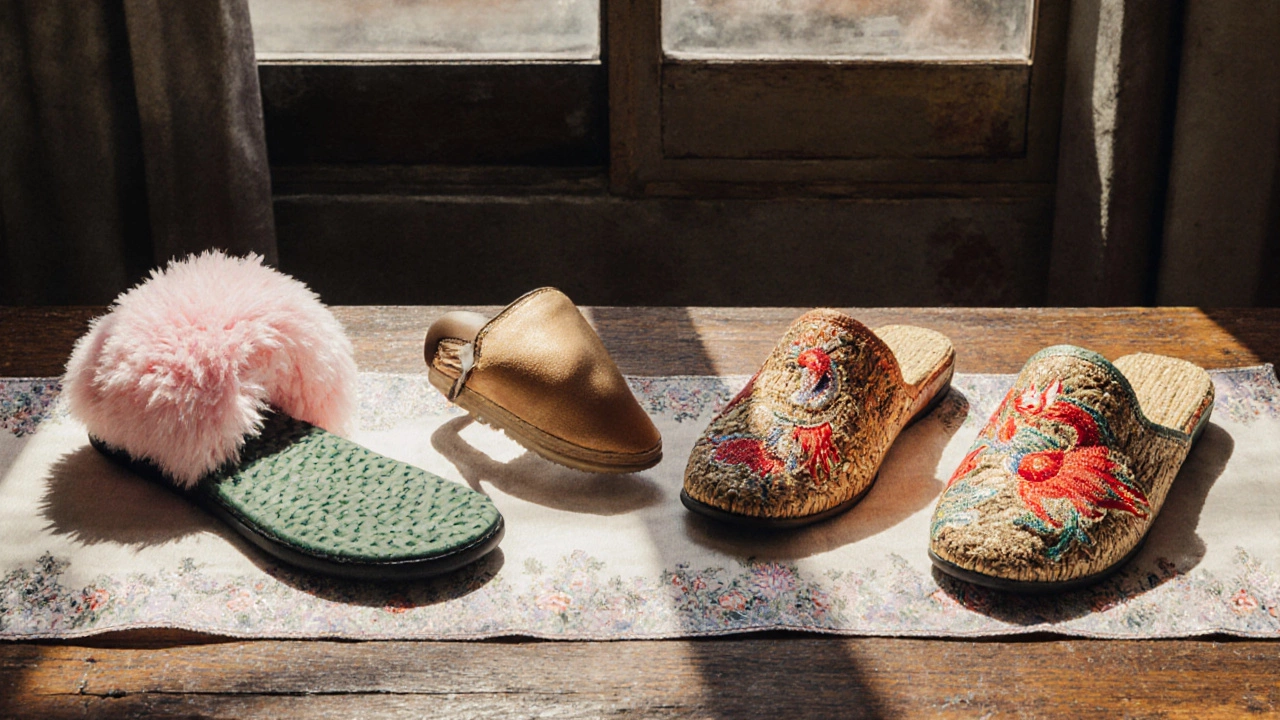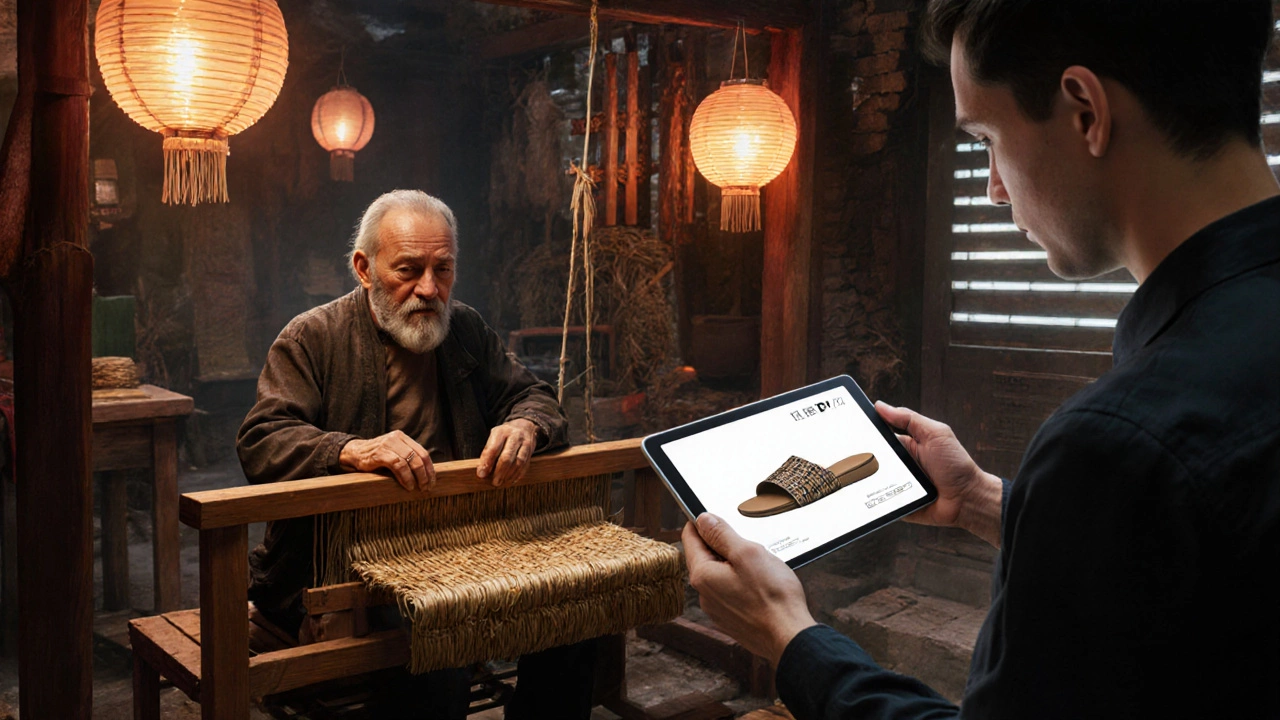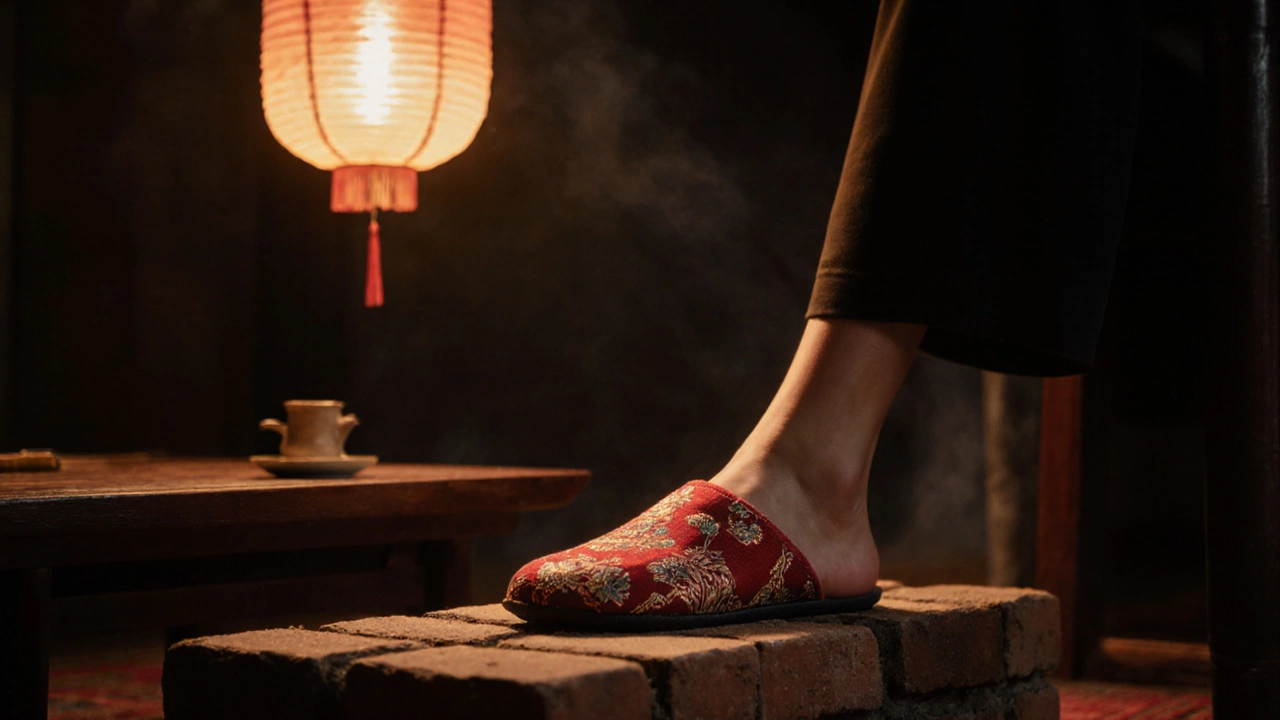When you hear the term Chinese slippers is a traditional indoor footwear from China, often made of cloth, cotton, or woven straw and known for its soft sole and cultural significance, you might picture a simple slip‑on that keeps your feet warm on cold floors.
Why the Question Matters
Visitors to Chinese markets, tourists watching a TV drama, or people browsing online stores often wonder: “What are Chinese slippers called?” The answer isn’t one word-it’s a family of names that reflect material, region, and occasion. Knowing these names helps you shop intelligently, understand cultural references, and even pick the right pair for a themed party.
Key Types of Chinese Slippers
Below are the most common traditional styles. Each has a Chinese name, a literal English translation, and a typical use case.
- Bu Xie (cloth slippers) - made from cotton or silk brocade, usually worn at home during winter.
- Tuo Xie (indoor flip‑flops) - flat rubber or leather soles with a simple strap, popular in southern provinces.
- Cao Bian Xie (straw‑woven slippers) - hand‑woven from wheat or rice straw, often seen in rural festivals.
- Xiu Hua Xie (embroidered slippers) - feature intricate silk embroidery, traditionally given as wedding gifts.
Material Matters
Traditional Chinese slippers rely on locally available fibers. Cotton is prized for its softness and breathability, making it the go‑to fabric for Bu Xie. In the north, thicker cotton blends keep feet warm during harsh winters.
In contrast, Woven straw is harvested in the summer and turned into light, breathable Cao Bian Xie. The straw is split, twisted, and woven on a small loom, producing a flexible sole that is surprisingly durable.
Silk and satin appear in higher‑end Xiu Hua Xie, where the fabric serves as a canvas for Embroidery. Motifs range from phoenixes to lotus flowers, each carrying symbolic meaning. The embroidery thread itself is often made from silk or metallic yarn, adding a subtle shimmer.

When and Where They’re Worn
Historically, slippers were indoor‑only because traditional Chinese homes featured heated floors (the “kang”) in the north and tiled floors in the south. Wearing outdoor shoes inside was considered disrespectful. Bu Xie and Xiu Hua Xie were the go‑to choices during family gatherings or tea ceremonies.
Today, you’ll still see Tuo Xie in modern apartments because their rubber soles can handle both indoor tiles and occasional outdoor steps. Tourist areas in Shanghai and Beijing sell souvenir versions of all four types, often with bright colors aimed at foreign buyers.
Modern Adaptations and Where to Buy
Designers in major Chinese cities have re‑imagined these classics. Some add memory‑foam insoles, while others use synthetic leather to meet global standards. E‑commerce platforms like Taobao, JD.com, and even Amazon carry “Chinese house shoes” marketed under names such as “Traditional Bu Xie” or “Hand‑woven Straw Slippers”. When shopping online, look for these cues:
- Material description - cotton, silk, straw, or synthetic blend.
- Size chart - Chinese sizes run smaller; add a half size if you wear a US women’s 8.
- Craftsmanship details - hand‑woven versus machine‑produced.
- Return policy - especially for delicate embroidered pairs.
If you prefer a boutique experience, visit the Hutong districts of Beijing. Small workshops there still produce Bu Xie by hand, and you can watch the stitching process.
How to Care for Your Chinese Slippers
Because many pairs are made from natural fibers, proper care extends their life:
- Cleaning cotton or silk slippers: Hand‑wash in lukewarm water with mild detergent. Avoid harsh wringing; lay flat to dry.
- Stir‑woven straw shoes: Brush off dust with a soft brush. If they get wet, let them air‑dry away from direct sunlight to prevent cracking.
- Embroidered options: Spot‑clean only. Use a soft cloth dipped in diluted vinegar solution for stains, then rinse lightly.
- Storage: Keep them in a breathable cloth bag. Avoid plastic bags that trap moisture.

Quick Comparison of Traditional Styles
| Chinese Name | English Name | Typical Material | Common Use | Price Range (USD) |
|---|---|---|---|---|
| 布鞋 | Cloth slippers | Cotton, silk | Home, winter | 15‑40 |
| 拖鞋 | Indoor flip‑flops | Rubber, leather | Year‑round indoor/outdoor | 10‑25 |
| 草编鞋 | Straw‑woven slippers | Wheat or rice straw | Festivals, summer | 8‑20 |
| 绣花鞋 | Embroidered slippers | Silk, satin | Weddings, gifts | 30‑80 |
Frequently Asked Questions
What is the literal translation of “Bu Xie”?
"Bu" means cloth and "Xie" means shoe, so “Bu Xie” directly translates to “cloth shoe” or “cloth slipper”.
Are Chinese slippers only for indoor use?
Traditionally yes, especially the soft‑sole Bu Xie. Modern Tuo Xie often have sturdier soles that can handle brief outdoor trips.
How do I choose the right size?
Measure the length of your foot in centimeters, then compare it to the seller’s size chart. Chinese sizes run about one size smaller than U.S. women’s sizes, so add a half size if you’re between sizes.
Can I wear embroidered slippers daily?
They’re best saved for special occasions. The silk fabric and delicate stitching can wear out faster with daily friction.
Where can I buy authentic hand‑woven straw slippers?
Visit traditional markets in rural Zhejiang or the artisan stalls of Shanghai’s Yuyuan Garden. Online, look for sellers who mention “hand‑woven” and show close‑up photos of the straw weave.
Wrapping It Up
Now you know that “Chinese slippers” isn’t a single term but a family that includes Bu Xie, Tuo Xie, Cao Bian Xie, and Xiu Hua Xie. Each name tells you something about the material, the region, and the occasion. Whether you’re hunting for a cozy pair for your living room, a souvenir for a friend, or a culturally rich gift, you can pick the right style with confidence.
